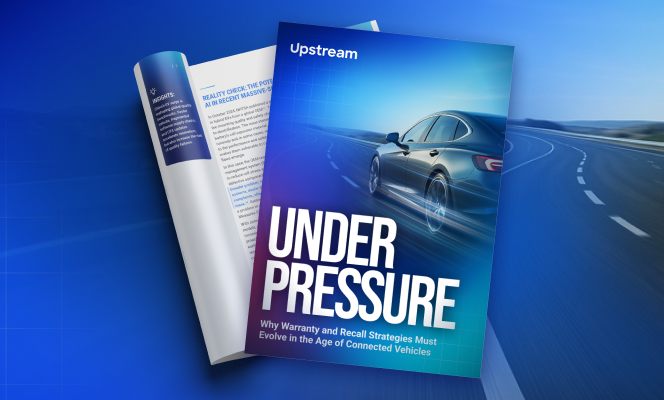

Vehicle Type Approval Made Simple: How a Global OEM Accelerated Compliance with Upstream
For today’s global automakers, securing Vehicle Type Approval (VTA) for connected vehicles is no small feat. Cybersecurity regulations such as UNECE WP.29 R155 and R156, similar to other evolving standards like the EU Cyber Resilience Act (CRA) and NIS2 Directive, demand clear, auditable processes for managing cyber risks across the entire vehicle lifecycle.
OEMs leveraging Upstream’s platform report that the cybersecurity components of VTAs have become significantly smoother and faster. With Upstream, OEMs can easily demonstrate how threats are monitored, which processes are in place, and how continuous follow-up and improvement are ensured, streamlining compliance and reducing friction with auditors and regulators.
A Robust Portfolio Purpose-Built for Cyber Resilience & Compliance
Upstream’s automotive cybersecurity suite delivers a comprehensive set of capabilities, fully aligned with regulatory expectations and industry best practices. Spanning real-time detection and response, contextual API security, proactive threat intelligence, and expert vSOC remediation, the suite provides end-to-end coverage of the entire vehicle ecosystem. This isn’t about stitching together fragmented tools, it’s a unified, data-driven approach that accelerates compliance while strengthening overall security.
UNECE R155 (CSMS) & R156 (SUMS) Compliance
Upstream provides the tools, processes, and reporting capabilities needed to meet regulatory requirements with confidence, demonstrating robust CSMS and SUMS frameworks designed to adapt swiftly to evolving risks. At the core of this capability is Upstream’s dedicated vSOC, which delivers continuous monitoring, incident detection, and expert remediation across the entire connected vehicle ecosystem. The vSOC not only ensures proactive threat management but also supports the generation of detailed, audit-ready reports required for compliance with R155 and R156, ISO/SAE 21434, as well as other emerging global standards.
Real-time Threat Detection & Response (Vehicle XDR)
Upstream’s XDR platform enables continuous monitoring, detection, and effective response to cybersecurity threats across the entire connected vehicle ecosystem, from telematics, APIs, and mobile applications to backend services, cloud environments, and charging infrastructure. Purpose-built for the unique needs of the automotive and smart mobility ecosystem, Upstream’s platform correlates data from multiple sources, leveraging AI-powered analytics and contextualized live digital twins to detect anomalies, mitigate risks in real time, and provide clear, actionable insights. Detection coverage aligns with R155 Annex 5, addressing risks across key cybersecurity attack vectors identified by regulators. This proactive approach helps OEMs and mobility providers protect their assets, ensure compliance with evolving regulations, and maintain trust with customers and regulators alike.
Proactive and Automotive-Focused Threat Intelligence
Upstream’s AutoThreat® PRO leverages extensive datasets collected from millions of connected vehicles, mobility assets, and automotive cloud environments worldwide to deliver actionable insights on emerging cyber threats. It continuously monitors deep, dark, and surface web sources alongside proprietary telemetry data to uncover new attack vectors, threat actors, and indicators of compromise (IOCs) specific to the mobility landscape. AutoThreat® maps its intelligence to the attack vectors outlined in R155 Annex 5, helping OEMs prioritize and address risks that align with regulatory expectations. This intelligence enables OEMs and mobility providers to proactively identify vulnerabilities, adapt their defenses to evolving threats, and stay ahead of regulatory expectations. By transforming global intelligence into tangible, data-driven actions, Upstream helps ensure both ongoing compliance and enhanced vehicle security across the entire ecosystem.
Data-Driven Evidence for Audits
Upstream simplifies the collection, analysis, and presentation of comprehensive security data. This provides the documentation and proof required for regulatory audits, a critical step in securing and maintaining Vehicle Type Approval.
Compliance as a Strategic Advantage: Enhanced Security, Smoother Processes, Stronger Reputation
For leading OEMs, working with Upstream transforms cybersecurity from a compliance requirement into a strategic advantage. With clear processes, real-time monitoring, and proactive intelligence in place, organizations can accelerate approval timelines while simultaneously strengthening their overall vehicle security posture and enhancing brand reputation.
Driving Better Outcomes with Upstream:
- Smoother, faster VTA processes for cybersecurity components
- Clear, auditable processes for threat monitoring and response
- Increased confidence from auditors and regulators
- Strengthened alignment with evolving global standards
Vehicle Type Approval is more than a regulatory requirement, it’s a statement of trust. Leading OEMs understand that robust cybersecurity is essential not just for compliance but for long-term success in an increasingly connected and autonomous world.
Upstream’s platform, purpose-built for the automotive ecosystem, turns compliance into a competitive edge by enabling faster approvals, enhanced security, and operational peace of mind.

